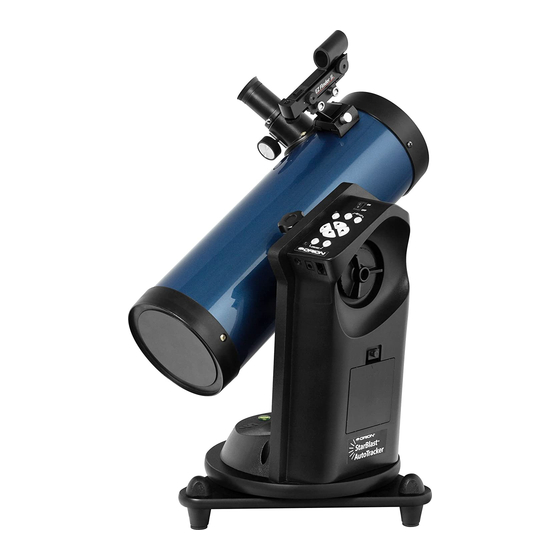
Table of Contents
Advertisement
Quick Links
Advertisement
Table of Contents

Summary of Contents for ORION TELESCOPES & BINOCULARS StarBlast AutoTracker 10140
- Page 1 inSTrucTiOn MAnuAl Orion StarBlast 114mm ® ™ AutoTracker ™ #10140 OrionTelescopes.com Customer Support (800) 676-1343 E-mail: support@telescope.com Corporate Offices (831) 763-7000 89 Hangar Way, Watsonville, CA 95076 Providing Exceptional Consumer Optical Products Since 1975 IN 487 Rev. A 05/13...
-
Page 2: Parts List
introduction Congratulations on your purchase of the Orion StarBlast tele- scope! Take time to read through this manual before embark- ing on your journey through the heavens. Please read the separate AutoTracker Mount Manual (IN 489) for all information relating to the mount and its accessories. Your StarBlast telescope is designed to give you years of fun and exciting astronomical observations. -
Page 3: Telescope Basics
Turn the power knob (Figure 4) clockwise until you hear the “click” indicating that power has been turned on. Look through the back of the reflex sight with both eyes open to see the red dot. Position your eye at a comfortable distance from the back of the sight. -
Page 4: Image Orientation
For astronomical viewing, out of focus star images are very dif- The 25mm eyepiece has an apparent field of view of 49°. fuse, making them difficult to see. If you turn the focus knob Divide 49° by the magnification, which is 20 power. This yields too quickly, you can go right through focus without seeing the an actual field of view of 2.45°. -
Page 5: Lunar Observing Hints
lunar surface. At low power you will be able to see most of the to see them. Visually, they are too faint to reveal any of the color seen in long exposure photographs. Instead, they appear lunar disk at one time. Change to higher power (magnification) to focus in on a smaller area. -
Page 6: Telescope Maintenance
Telescope Maintenance While your StarBlast telescope requires little maintenance, there are a few things to remember that will ensure your tele- scope performs at its best. care and cleaning of the Optics In general, your telescope’s mirrors will only need to be cleaned very infrequently, if ever. -
Page 7: Specifications
Adjusting the Secondary Mirror’s Tilt The tilt of the secondary mirror may occasionally require adjustment. If the entire primary mirror reflection is not visible in the secondary mirror when using the collimation cap, as in Figure 5b, you will need to adjust the tilt of the secondary mirror with the three recessed setscrews surrounding the cen- ter screw (Figure 6). -
Page 8: Glossary Of Terms
glossary of Terms with individual components that can be seen separately by a telescope are called visual binaries or visual multiples. The nearest “star” to our solar system, Alpha Centauri, is actually our nearest example of a multiple star system, it Absolute magnitude: The apparent magnitude that a star consists of three stars, two very similar to our Sun and would have if it were observed from a standard distance... - Page 9 to a ratio of 2.5 in brightness. Thus a star of magnitude astronomical units, or 30,8000,000,000,000 km. (Apart 1 is 2.5 times brighter than a star of magnitude 2, and from the Sun, no star lies within one parsec of us.) 100 times brighter than a magnitude 5 star.
-
Page 10: Time Zones
Time Zones... - Page 12 Sky Maps...
-
Page 18: One-Year Limited Warranty
One-Year limited Warranty This Orion product is warranted against defects in materials or workmanship for a period of one year from the date of purchase. This warranty is for the benefit of the original retail purchaser only. During this warranty period Orion Telescopes & Binoculars will repair or replace, at Orion’s option, any warranted instrument that proves to be defective, provided it is returned postage paid.
















Need help?
Do you have a question about the StarBlast AutoTracker 10140 and is the answer not in the manual?
Questions and answers